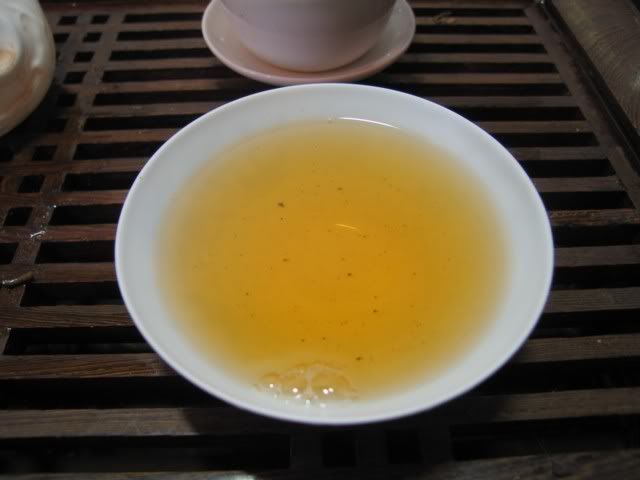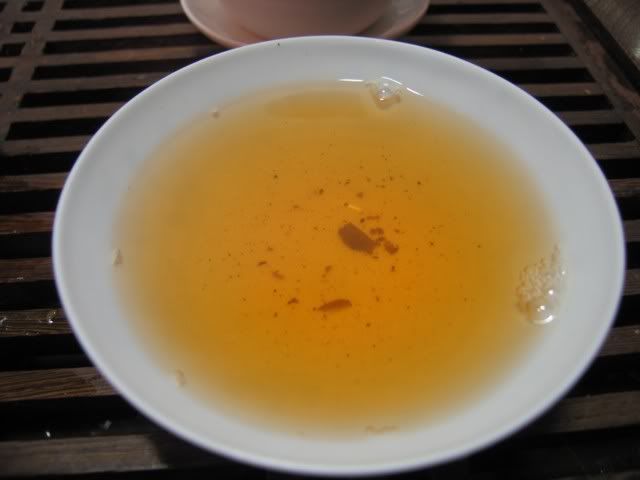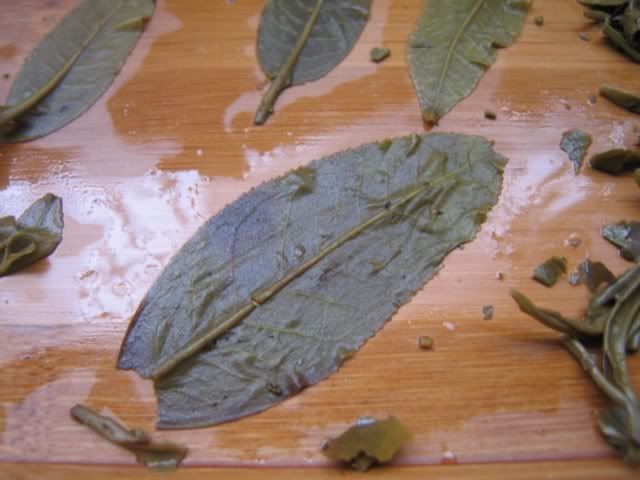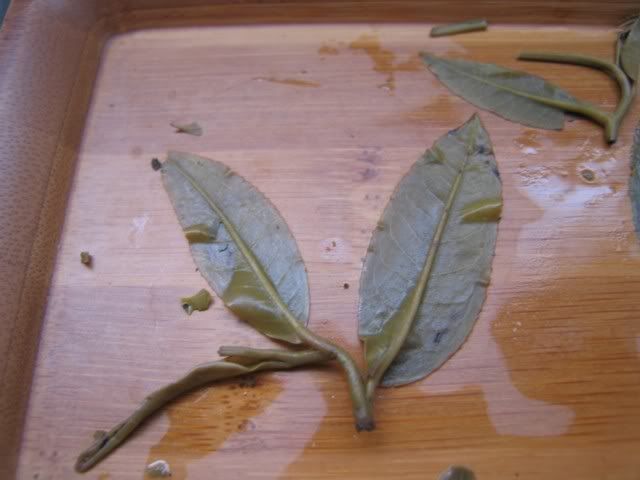As promised, I tasted Sample 1 today.
I suppose I should tell you first what it is. I actually blogged about this tea when I bought it. I wonder if any of you might’ve thought sample 1 to be this cake. This is a 2003 Bulang cake, supposedly old tree tea.




I sang high praises of the tea when I bought it. I tried it once more in Shanghai. At that sitting, I had a little wavering of opinion, and I decided to send this cake out after thinking about it for a few days. Then I picked up sample A along the way and made it a two sample deal.
Before I say more, maybe I should tell you about my tasting today. I used 7.2g of tea in the same gaiwan as yesterday

But with slightly different timings for my infusions. Someting like 3, 3, 3, 5, 5, 5, 10, 30, 30, 30, 60, 120, 300. Yes, very short. 3 second infusions are basically pouring the water in, putting the water boiler down, and pouring the tea out. 5 seconds just involves a slight pause as I put my hand on the gaiwan.
1 — bitterness opening up, with a flash of sour following through. When swallowed, the tea travels a bit down the throat. Qi present, with a huigan developing. Thick. Hint of smoke, with a smell of cigarettes under the lid of the gaiwan.
2 — Thick , less bitter than the last one. There’s a very small hint of something a little more floral, but it’s almost nonexistent. I can see why some people thought this tea tasteless, as it is indeed rather bland, flavour wise. Swishing the tea around the mouth, there’s a certain leafy/grassy taste to it, but yes, bitter. Fairly smooth, despite the stiffness of the tea.
3 – Smelling the lid now, the smoke is gone, replaced by the beginning of notes of sweet fruit. But wait… Letting it cool a bit reveals a bit more smoke. Tea is obviously less orange than sample A. It is also obviously much thicker, if you notice, for example, the bubbles and they way they sit on this tea compared with sample A. A fuller “tea” taste now, slightly minty. Reminds me a little of the Yibang maocha I had a while ago. Aftertaste is strong, a little more drying now, but not that bad.
4 — Slightly longer infusion time gave me more bitterness than the last infusion. I’m sweating now.
5 — There isn’t a lot of flavour I can talk about, to be honest with you, other than a generic “tea” flavour that I think is present throughout. Having waited longer during this infusion before brewing it, I could feel the throatiness of the tea, and the huigan that reminds me I have had something just now.
6 — The bitterness and harsh nature peaked around infusion 4, I think, and now it is possible to drink it without having to worry about that. Some astringency now, but not very strong and certainly better than a lot of teas I’ve had. I think the buddy nature of the tea has something to do with it, at least according to knowledgeable friends.
7 — This really reminds me of some of those maocha I’ve had recently, which I think is a good thing to be reminded of. It’s not like a Yiwu or even a Manzhuan, where they are more fruity/floral. Rather, it is heavy hitting, maybe closer to a Gedeng or Yibang. This is, of course, not from any of those areas. There’s a hint of that aroma of sweet plum or something like that in the after-after-taste now, the same thing that I can smell from the dry leaves. Took 7 infusions to see it, but it’s there. Under the lid smells like a typical raw, young puerh, with a bit of that “smelly green smell”, for lack of a better term.
8 — Harshness vanished, despite the longer brew of about 30s. The tea is now pretty full and soft, the tongue is still a little rough, but again, not too bad. There’s that minty smell/flavour to the tea.
9 — Tea is still pretty thick and full bodied. Under the lid smell went to a more pleasant aroma. No hint of watery taste, yet.
10 — Similar to the last one, a little thinner.
11 — Longer infusion again. The flavour and the body are thinning a little now. Tea slightly cloudy probably because I toyed with the wet leaves. The same plumy aftertaste shows up much belated, again.
12 — Ok, I’m going to stop taking notes, as there’s probably little more that’s interesting to report. But the tea is still going. I went on for a few more infusions without taking more notes.
The following pictures are infusions 1, 3, 5, 9, 11





I had in mind other people’s comments about the bitter nature of the tea, and so paid special attention to how it fares. The opening bitterness is very strong, almost overwhelming, especially if you don’t expect it. I used a very short infusion. Some of you opened with 15s for your first infusion, which I can imagine will be quite unpalatable. I suppose I never do long first infusions, so I never thought to warn people about that. In retrospect, I should’ve at least told everybody to beware of overbrewing this tea, as I knew it’d be harsh and a tough one to swallow if brewed too long.
The bitterness starts to lose its edge around the 4th infusion, and dies by the 7th or 8th. Some of you gave up long before that, so I suppose there’s not much to say about that, and I can understand why. I don’t find the tea rough though, but any tea will be made rougher if the infusions are longer, so my short infusion times might’ve helped that.
Casper asked about bitterness. I personally have learned to distinguish two types, the puerh one and the green tea one. The puerh bitterness, typified by this one, is changable. It will go away, if you’re patient enough and pay attention. The bitterness will eventually “melt”, in Chinese parlance, into a sweetness of sorts. This refers to the way the taste reacts in your mouth — when you’ve swallowed the tea, the bitterness should eventually disappear into a sweet sensation. It could take a while in some cases. The same is true for the tea in general — as infusions go on, the tea turns sweet.
The green tea bitterness, on the other hand, will not do this. I find it to be lingering on your mouth, and only gets worse. This kind of bitterness hits you on the tongue, feeling like I’ve just licked something really bitter. It stays, and stays, and stays, and never quite goes away even in later infusions. Makes sense — green teas are usually sweet early and bitter late, if you think about it. Puerh is the other way around. You want the kind that does the bitterness early and the sweet late.
This tea, funny enough, reminds me of some of the maocha I’ve had recently from that 6 mountain sample pack. It is similar to the Yibang or the Wangzhi, especially after the initial wave of bitterness dies down. Bulang is supposed to be bitter, and you can all see why. I take the similarity to those six mountain maocha as a good sign though.
Here are some wet pictures




Now, perhaps I should explain why I thought this tea good. Some of you have noted that it is quite an energetic tea, although not all agreed. I would lean towards the energetic side. I would also say that I thought the tea to be rare in the sense that — I can’t seem to pick out any problems. The smoke, while there, is very light and will probably go away soon (and washes away anyway in about two infusions). The bitterness will turn into sweetness, eventually. The tea is strong, has durability, and doesn’t suffer from problems of pre-fermentation or green-tea processing (bitterness would be lasting and not turn if it did). It’s not even very rough, all things considered. It’s not even expensive. I really can’t find a big fault with this tea.
There are two problems. One is that it is not that complex, but I believe that will develop over time, and shouldn’t be judged now. The other is that it is very tightly compressed. It would age slowly. It also contributed to the brokenness of the tea I sent to you. I didn’t have the right tools with me in Shanghai to break it apart, and should’ve gotten a pick earlier. Sorry about that.
So…. why did I send these two teas out?
Well, initially, I thought sample 1 would be a good example of a young puerh. I felt it has good aging potential, with a strong flavour, good body, and no real problems. I know that’s a strange criteria for saying a tea is good, but so often I drink young puerh these days that has something or another that’s odd, that it’s rare for me to find something I couldn’t really pick a fault in. Then, as I was trying sample A in the store, I thought to myself that… perhaps sample 1 isn’t going to be to everybody’s taste, given its harshness. Sample A would prove a nice contrast in almost every way — more drinkable, no bitterness, fruity, but a bit thin, a bit weak, and a bit less certain on the aging question. Why not?
I also sent the samples to Tiffany of Best Tea House for an opinion. I didn’t get much of one, but she did say she prefers 1 more than A. She thought A was odd, and 1 was “stiff” (the same way a vodka can be stiff). But she likes 1 because it’s got good potential.
I should add, as a final note, that both teas cost about the same. Surprised?
Thanks to everybody who gave me the comments. It was definitely enlightening to see all the different reactions, and I certainly learned more about these two teas while reading through the comments. I also realized the importance of putting in some tasting parameters from time to time. I realized that mine are probably not typical, so what I note in my teas a lot of people might not see, simply because of the fairly different ways of brewing tea.
P.S.: Everything said here and yesterday has been said in an authoritative manner. However, I should remind my readers that I, as much as you, am learning about this as I go along. Writing about this sort of thing with a lot of caveats and qualifiers makes for a difficult read, and also makes it hard to write. So, don’t take this (or anybody else’s words) as holy gospel, but instead form your own opinions based on your own observations. This blog, after all, was started more for my own record-keeping and observations than anything else. 🙂

9 responses so far ↓
Phyllo // June 1, 2007 at 11:59 am |
Interesting! I’ll retaste this tea by itself. One drawback of doing a side-by-side tasting is that it’s harder to know which tea an aftertaste come from…especially when the aftertaste is forthcoming rather slowly. Thanks for the feedback.
MarshalN // June 1, 2007 at 12:29 pm |
Yes, that’s definitely one problem with side-by-side. The other is that some flavours will be masked because one is stronger than the other and covers it up. So, say, if there’s any fruit taste in this, you won’t notice because A is much more fruity.
Side by side is probably best for teas that are rather comparable, like two Yiwus or something. For these two that are so diametrically different…. it’s probably not the best way to taste them.
lewperin // June 1, 2007 at 1:10 pm |
Thanks for the careful observations (as usual.) It’s great being able to read you again after 3 weeks away where the Internet was … filtered. I really loved the entries about your ancestral home town.
You mention that you “didn’t have the right tools with me in Shanghai” to separate the leaves with minimum breakage. I’ve been worrying about this lately, so I wonder what you’d use under the best circumstances.
MarshalN // June 1, 2007 at 1:21 pm |
I like picks — the really sharp, needle looking kind. For tight bings I personally find them the best. Anything less sharp don’t really penetrate the bing and will create a lot of dust — which I did.
HobbesOxon // June 1, 2007 at 1:36 pm |
So, all is revealed! Thanks for the detail, always appreciated. It’s a crime that both these teas cost the same amount… 🙂
I’ve never come across Quanji before, so this was very interesting. I’ll definitely go over this tea again.
Toodlepip,
Hobbes
MarshalN // June 1, 2007 at 1:47 pm |
It’s a crime in which direction? 🙂
kibi_kibi // June 1, 2007 at 4:11 pm |
Yes, thank you for the samples, it was certainly a rather interesting experience!
Actually I know this thread is about 1, but somehow now I’ve realised that whenever I think back to A, it reminds me of that 98 MH sample from Hou De (the one Hobbes blogged about not so long ago), there is something similar about those two teas… just a thought.
-vl.
MarshalN // June 2, 2007 at 1:31 am |
Hobbes…. do you still have any sample A left? Or the 98 Hou De?
It’ll be curious to see if vl is right on this one.
HobbesOxon // June 2, 2007 at 12:50 pm |
I have indeed, I’ll give it another go.
Vlad, do you mean the 1998 Menghai 8582, or the 1998 Menghai tuocha? The former was the Houde, of course.
To my tastes, I don’t notice sample A being overly similar to either. The former is really lovely, being rich and enjoyable. The latter is the usual Menghai mushroom extravaganza.
Sample A (the CNNP “Yiwu”) was highly unusual for me: both I and someone else (Dave/Mike?) observed a urine-like aroma (heh), with cigarettes, and plenty of muted fruits, without much else going on.
Maybe I can try them mano-et-mano, in a no-holds-barred gaiwan face-off to the bitter end.
Toodlepip,
Hobbes